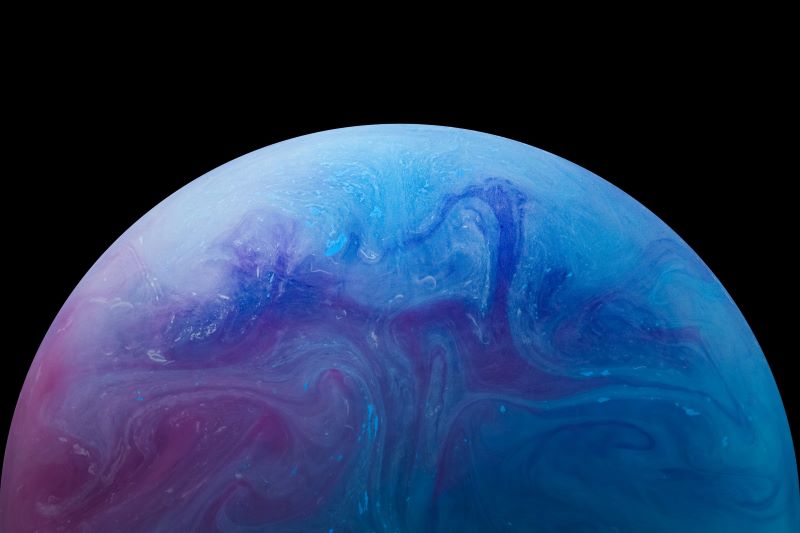New evidence for Planet 9 at the fringes of our solar system
Researchers said the bunching of small objects beyond Neptune fits perfectly with the existence of a Planet 9 hiding on the outskirts of our solar system.
The post New evidence for Planet 9 at the fringes of our solar system first appeared on EarthSky.

New evidence for Planet 9
The case is growing that a Neptune-sized planet – Planet 9 – hides deep in the outskirts of our solar system. Researchers from Caltech, Université Côte d’Azur and Southwest Research Institute shared a pre-print paper on April 17, 2024. In it, they argue that a group of little bodies beyond Neptune bunch together due to Planet 9’s gravitational influence. These distant solar system bodies aren’t spread equally in their orbit like the rocky boulders of the asteroid belt. Instead, they form clumpy groups. So, the researchers think that a larger, more distant, object is gravitationally herding them into this pattern. And, in fact, that’s how planet eight – Neptune – was discovered. Neptune was yanking on Uranus’ orbit.
Two of the four authors on the new paper, Konstantin Batygin and Mike Brown of Caltech, are the originators of the theory of Planet 9. In fact, Mike Brown wrote a book about his life and research in the far edges of our solar system, including the re-classification of Pluto. The book is titled How I Killed Pluto and Why It Had It Coming. But these researchers believe there’s an object much larger than Pluto farther out in our solar neighborhood. This planet would be the size of five Earths (about the size of Neptune) and lie 400 to 800 times farther from the sun than Earth.
The Astrophysical Journal Letters has accepted the paper for publication. It is not yet peer-reviewed. A copy of the paper is available on arXiv.
Batygin on Event Horizon podcast
Batygin said on John Michael Godier’s podcast Event Horizon that this is:
… the fifth and most statistically significant evidence we have to date for the existence of Planet 9.
Batygin also said:
What we looked at in this paper is a population of Trans-Neptunian Objects that we had ignored up until now. These are populations of long-period icy asteroid-like things that typically live beyond the orbit of Neptune … but have orbits that pierce the orbit of Neptune. We also specifically looked at the population of Neptune-crossers that live close to the plane of the solar system.
So, because the objects cross Neptune’s orbit and are getting pushed around by the giant planet, if left alone they would have dispersed. As Batygin said:
The fact that we see them at all necessitates some form of gravitational influence. … What we show in this paper is that not only is Planet 9 up to the task, moreover it’s that the orbital distribution that Planet 9 predicts is perfectly consistent with what we see in the data.
In fact, Batygin said that a solar system without a Planet 9 can be ruled out with a confidence of five sigma. This value, for fields such as particle physics, is considered enough to declare a discovery. It’s a “gold standard,” equal to about a one-in-a-million chance that result was random.
Planet 9, galactic tide or black hole?
Are there any other theories besides Planet 9 that could explain the bunching of the Trans-Neptunian Objects? One of those theories concerns the galactic tide. And the researchers looked at this gravitational pull from the galaxy itself. But they found that some features of the distribution of objects can’t be reproduced with the galactic tide. However, the Planet 9 theory fit perfectly.
Another theory, not discussed in the paper, is that Planet 9 could instead be a black hole. If there are black holes roaming way out in the distant solar system, Harvard astronomer Avi Loeb has proposed a way to search for them. They would look for flares from black hole encounters with small, distant objects.
The upcoming Vera Rubin Observatory might be just the tool to provide the crucial data to solve the mystery of Planet 9 or solar system black holes. The telescope should be up and running by the beginning of 2025.
Unfortunately, the new data from the recent study does not help us find the direction to point our telescopes to see Planet 9. So the hunt continues.
Announcement on social media
Here’s how lead author Konstantin Batygin announced the discovery on social media:
A key early clue for Planet 9 emerged nearly a decade ago: large-perihelion Kuiper Belt objects cluster together. Gravitational scattering from Neptune disrupts this patter, so focus remained on dynamically stable (Sedna-like) TNOs, ignoring the unstable ones. pic.twitter.com/YNZ0Yrauy3
— Konstantin Batygin (@kbatygin) April 18, 2024
Given their dynamic instability, only two scenarios can maintain this population of TNOs in a steady state: they're either driven inward by interplay between the Galactic tide and Neptune's scattering, or they result from dynamics induced by Planet 9 (as shown on the figure). pic.twitter.com/HBEqm0UO9J
— Konstantin Batygin (@kbatygin) April 18, 2024
But what about observational bias? After adjusting for it, the data favor the Planet 9 model at a striking 5 sigma level. Surprisingly, this "unexotic" group of TNOs provides the strongest statistical evidence yet that Planet 9 is really out there… pic.twitter.com/LksVpOyfS1
— Konstantin Batygin (@kbatygin) April 18, 2024
Bottom line: Researchers said the bunching of small objects beyond Neptune’s orbit fits perfectly with the existence of a Planet 9 hiding on the outskirts of our solar system.
Source: Generation of Low-Inclination, Neptune-Crossing TNOs by Planet Nine
The post New evidence for Planet 9 at the fringes of our solar system first appeared on EarthSky.
